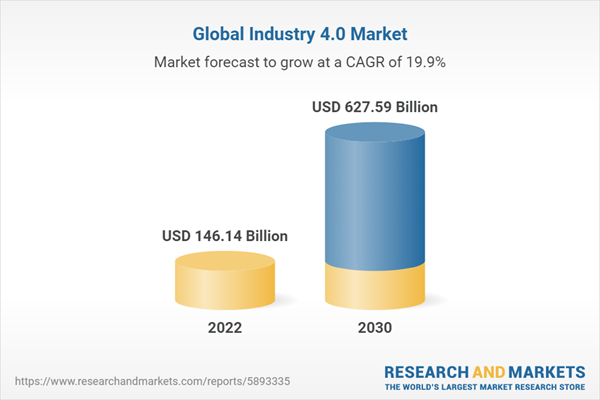The global Industry 4.0 market size is expected to reach USD 627.59 billion by 2030. It is expected to grow at a CAGR of 19.9% from 2023 to 2030. The growth of the market is attributed to the widespread adoption of the Internet of Things (IoT) devices and sensors, facilitating seamless data integration, while the infusion of Artificial Intelligence (AI) and Machine Learning (ML) is propelling predictive analytics and autonomous operations. Furthermore, the rising consumer spending on digitalization and cutting-edge factory solutions will increase demand for Industry 4.0 solutions.
Industry 4.0 emphasizes the creation of interconnected ecosystems where devices, machines, and systems communicate and collaborate seamlessly. This trend leads to streamlined information flow, enabling real-time decision-making based on accurate and up-to-date data. Edge computing, which processes data closer to its source, and cloud integration are trends supporting this interconnection. The deployment of Industry 4.0 solutions optimizes resource utilization, energy consumption, and overall process efficiency. With real-time data collection and analysis, companies gain insights into operational bottlenecks, allowing for timely adjustments and continuous improvement. Trends, such as digital twins (virtual replicas of physical assets), enable simulation and optimization of processes, thereby enhancing efficiency.
The transition to Industry 4.0 requires a workforce with the necessary skills to operate and maintain advanced technologies. However, there is often a shortage of workers with expertise in data analytics, robotics, and cybersecurity. Businesses may need to invest in training and upskilling programs to ensure that their workforce can effectively leverage Industry 4.0 technologies. Implementing Industry 4.0 technologies often requires a significant upfront investment. The costs associated with acquiring and deploying advanced machinery, sensors, data analytics systems, and connectivity infrastructure can be substantial. Small and medium-sized enterprises (SMEs) may face financial constraints in adopting these technologies, limiting their ability to compete with more prominent industry players.
In the evolving market, the robotics and automation trend encompasses several transformative elements, including collaborative robots designed for safe human interaction and the integration of intelligent Robotic Process Automation (RPA) that streamlines repetitive tasks and processes. Advanced sensing and perception capabilities enable robots to interact more effectively with their environment, bolstering accuracy and adaptability. Furthermore, the infusion of AI and ML empowers robots to learn, adapt, and make real-time decisions, augmenting their problem-solving ability.
The North America regional market growth is driven by the need to address labor shortages and rising operational costs. Automation and robotics were integrated into manufacturing processes to perform repetitive tasks, reducing the reliance on manual labor. This shift not only improved efficiency but also enhanced workplace safety. With improved cost-effectiveness, regional manufacturers were better positioned to compete globally. IoT played a pivotal role by connecting devices and machinery to the internet, enabling real-time data collection and analysis. This data-driven approach allowed companies to monitor equipment performance, predict maintenance needs, and optimize production processes. The insights from IoT-powered analytics enhanced decision-making reduced downtime, and minimized resource wastage.
Industry 4.0 emphasizes the creation of interconnected ecosystems where devices, machines, and systems communicate and collaborate seamlessly. This trend leads to streamlined information flow, enabling real-time decision-making based on accurate and up-to-date data. Edge computing, which processes data closer to its source, and cloud integration are trends supporting this interconnection. The deployment of Industry 4.0 solutions optimizes resource utilization, energy consumption, and overall process efficiency. With real-time data collection and analysis, companies gain insights into operational bottlenecks, allowing for timely adjustments and continuous improvement. Trends, such as digital twins (virtual replicas of physical assets), enable simulation and optimization of processes, thereby enhancing efficiency.
The transition to Industry 4.0 requires a workforce with the necessary skills to operate and maintain advanced technologies. However, there is often a shortage of workers with expertise in data analytics, robotics, and cybersecurity. Businesses may need to invest in training and upskilling programs to ensure that their workforce can effectively leverage Industry 4.0 technologies. Implementing Industry 4.0 technologies often requires a significant upfront investment. The costs associated with acquiring and deploying advanced machinery, sensors, data analytics systems, and connectivity infrastructure can be substantial. Small and medium-sized enterprises (SMEs) may face financial constraints in adopting these technologies, limiting their ability to compete with more prominent industry players.
In the evolving market, the robotics and automation trend encompasses several transformative elements, including collaborative robots designed for safe human interaction and the integration of intelligent Robotic Process Automation (RPA) that streamlines repetitive tasks and processes. Advanced sensing and perception capabilities enable robots to interact more effectively with their environment, bolstering accuracy and adaptability. Furthermore, the infusion of AI and ML empowers robots to learn, adapt, and make real-time decisions, augmenting their problem-solving ability.
The North America regional market growth is driven by the need to address labor shortages and rising operational costs. Automation and robotics were integrated into manufacturing processes to perform repetitive tasks, reducing the reliance on manual labor. This shift not only improved efficiency but also enhanced workplace safety. With improved cost-effectiveness, regional manufacturers were better positioned to compete globally. IoT played a pivotal role by connecting devices and machinery to the internet, enabling real-time data collection and analysis. This data-driven approach allowed companies to monitor equipment performance, predict maintenance needs, and optimize production processes. The insights from IoT-powered analytics enhanced decision-making reduced downtime, and minimized resource wastage.
Industry 4.0 Market Report Highlights
- Industry 4.0 marks the next phase of manufacturing digitization, driven by disruptive trends like connectivity, data, human-machine interaction, analytics, and robotics. It also includes the enhancement of manufacturing efficiency through the integration of technology and automation into both production and managerial workflows
- The demand for IoT is increasing in most sectors, and the role played by solution providers and vendors is further contributing to its extravagant growth. Numerous initiatives at the industry level have been promoting and advertising IoT applications and their use cases
- Industry 4.0 thrives on data collection and analysis. With the proliferation of sensors and connected devices, companies gather vast amounts of data that can be leveraged for informed decision-making
- The consistent advancement of additive manufacturing technologies has led to heightened capabilities in terms of precision, speed, and scalability. Innovations in materials, printing techniques, and post-processing methods have collectively contributed to making 3D printing a feasible and effective solution across industries
Table of Contents
Chapter 1 Methodology And Scope
Chapter 2 Executive Summary
Chapter 3 Industry 4.0 Market - Industry Outlook
Chapter 4 Industry 4.0 Market: Component Estimates & Trend Analysis
Chapter 5 Industry 4.0 Market: Technology Estimates & Trend Analysis
Chapter 6 Industry 4.0 Market: Industry Vertical Estimates & Trend Analysis
Chapter 7 Regional Estimates & Trend Analysis
Chapter 8 Industry 4.0 Market - Competitive Landscape
List of Tables
List of Figures
Companies Mentioned
- ABB Ltd.
- Cisco System Inc.
- Cognex Corporation
- Denso Corporation
- Emerson Electric
- Fanuc Corporation
- General Electric Company
- Honeywell International Inc.
- Intel Corporation
- Johnson Controls International
- Kuka Group
- Robert Bosch Gmbh
- Rockwell Automation Inc.
- Schneider Electric Se
- Siemens Ag
Methodology

LOADING...
Table Information
| Report Attribute | Details |
|---|---|
| No. of Pages | 140 |
| Published | September 2023 |
| Forecast Period | 2022 - 2030 |
| Estimated Market Value ( USD | $ 146.14 Billion |
| Forecasted Market Value ( USD | $ 627.59 Billion |
| Compound Annual Growth Rate | 19.9% |
| Regions Covered | Global |
| No. of Companies Mentioned | 15 |









